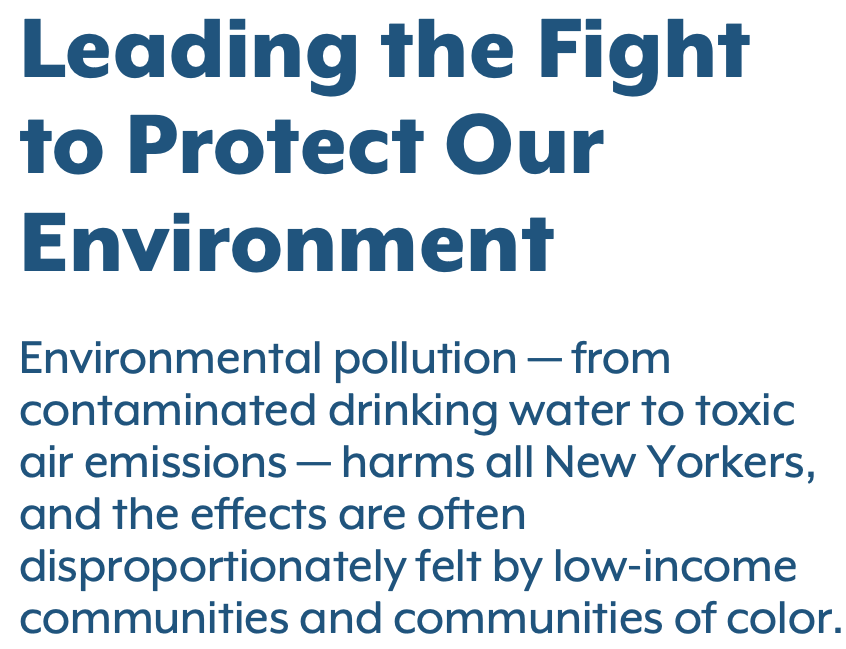
Brand Guidelines
The Office of the New York State Attorney General (OAG) brand must be consistent in both look and feel to easily be identified and carry authority. Our brand must meet specific accessibility guidelines that allow users with disabilities to view and understand our content using assistive technologies and mobile devices. The following are rules and guidelines for creating OAG content in various formats and mediums.
The brand guidelines only to public-facing content like:
- communications with the public and other governments
- publications
- mailers
- memos
- website
They do not apply to:
- mediation
- investigations
- litigation
- appeals
- amicus filings
- communications with other law firms, witnesses, subjects, targets, court filings, and the court
Accessibility
Accessibility in this context means that websites, documents, media, tools, and technologies are designed and developed so that people with disabilities can use them. Accessibility also benefits people without disabilities — rules and guidelines are in place so people can perceive, understand, navigate, and interact with what they are viewing.
Accessibility encompasses all disabilities that affect access to the web, media, and documents, including:
- auditory
- cognitive
- neurological
- physical
- speech
- visual
Guidelines to ensure we are creating accessible content:
- design — must check to make sure it passes visual rules for accessibility
- videos — must be captioned
- documents — must be checked for accessibility
- links — must have context; never use generic text like “click here”
Writing
Plain language
Plain language is a style of writing that focuses on improving how we communicate information to people with different levels of literacy or understanding. When we write with plain language, we remove hard-to-understand language or jargon, helping the reader understand more quickly and clearly.
Think about your reader. Who will read this content? What are they looking for? What will they do as a result? Use a conversational tone that fits your reader. Choose words they understand.
Give the big picture. Start with the most important information, then details. End with your “call to action,” or what you want the reader to do. If your content is long, put the call to action earlier.
Be direct. Use present tense and active voice. Use “you” and “we” to address the reader. Try to stick to a simple subject-verb-object sentence structure.
Before — 100% passive
It will be determined whether the consumer’s case may be considered as a possible future candidate for arbitration.
After — 0% passive
We will tell you if we can help you with your case.
Keep it short and simple. Avoid jargon, acronyms, and unneeded words. Define technical terms. Keep sentences short — you should be able to read each sentence aloud without taking a breath.
Before — grade 13
Junk bonds: These are high-yield, high-risk bonds of two types: those which are investment-grade when originally issued, but which have subsequently been downgraded, and those originally issued as low-grade bonds. The latter group includes bonds issued by low-rated companies to finance operations, as well as those issued in connection with corporate takeovers.
After — grade 5
Junk bonds: These are riskier bonds that offer high yields but have low ratings. A junk bond may have started out with a low rating, or its rating may have been downgraded. The low rating shows that the ratings agency has low confidence that the issuer can pay back its debt. Junk bonds are usually issued by corporations.
Chunk your information. Have one idea per sentence. Use bulleted lists. Keep paragraphs short. Break up information into easy-to-digest sections with descriptive headings and subheadings.
Avoid clutter. Use plenty of white space, a readable typeface, and boldfaced headings. Do not use too many different colors, typefaces, or images.
Try technology. Use Microsoft Word’s built-in readability tool (File -> Options -> Proofing -> Show Readability Statistics) or hemingwayapp.com to flag issues like passive voice and difficult sentences.
Test your assumptions. Ask someone who knows nothing about the subject to read your document and accomplish a task. Can they understand the content? Can they find the information they want?
Naming conventions
Follow the guidelines below to ensure a consistent writing style across all OAG materials. If a topic is not covered below, refer to AP format for styles.
Agency/principal
Office of the New York State Attorney General (abbreviated as OAG). Never use “the” before "OAG" unless it’s at the start of a sentence.
Office of the New York State Attorney General (OAG)
CORRECT:
The Office of the New York State Attorney General (OAG) has 13 regional offices in the state. Across the state, OAG works to protect New Yorkers, combat crime, ensure public safety, defend civil rights, fight for workers, safeguard our environment, and more.
INCORRECT:
New York State Office of the Attorney General
NYS Office of the Attorney General
Office of the NYS Attorney General
The lawsuit was filed by the OAG.
Official titles
Introduce with full name first, then title and last name thereafter.
New York State Attorney General Letitia James (preferred)
New York Attorney General Letitia James
CORRECT:
New York State Attorney General Letitia James is the 67th attorney general. In her first term, Attorney General James focused on protecting vulnerable New Yorkers.
INCORRECT:
New York AG
NY AG Letitia James
Office and bureau naming conventions
Office
- Office of the New York State Attorney General
Attorney General
- New York State Attorney General Letitia James or New York Attorney General Letitia James
- Attorney General James (only to be used after full title introduced)
Administration Division
- Administrative Services Bureau (ASB)
- Budget and Fiscal Management Bureau (BFMB)
- Bureau of Internet & Technology (IT)
- Human Resources Management Bureau (HRMB)
- Information Security Office (ISO)
- Internal Control (IC)
- Legal Recruitment (LR)
- Legal Education and Professional Development (LEPD)
- Managing Attorney’s Office (MAO)
- Office of Diversity and Inclusion (ODI)
- Practice Technologies Group (PTG)
Criminal Justice Division
- Crime Proceeds Strike Force (CPSF)
- Criminal Enforcement and Financial Crimes (CEFC)
- Conviction Review Bureau
- Medicaid Fraud Control Unit (MFCU)
- Office of Special Investigation (OSI)
- Organized Crime Task Force (OCTF)
- Public Integrity Bureau (PIB)
- Real Estate Enforcement Unit (REEU)
Economic Justice Division
- Antitrust Bureau
- Consumer Frauds and Protection Bureau (CFB)
- Internet & Technology Bureau (BIT)
- Investor Protection Bureau (IPB)
- Taxpayer Protection Bureau (TPB)
Executive Division
- Constituent Services Bureau (CSB)
- Intergovernmental Affairs
- Policy and Legislative Affairs
- Press Office
- Public Information and Correspondence Unit (PICU)
- Records Access Office (FOIL)
Regional Affairs Division
- Binghamton Regional Office
- Brooklyn Regional Office
- Buffalo Regional Office
- Harlem Regional Office
- Nassau Regional Office
- Plattsburgh Regional Office
- Poughkeepsie Regional Office
- Rochester Regional Office
- Suffolk Regional Office
- Syracuse Regional Office
- Utica Regional Office
- Watertown Regional Office
- Westchester Regional Office
Social Justice Division
- Charities Bureau
- Civil Rights Bureau (CRB)
- Environmental Protection Bureau (EPB)
- Health Care Bureau (HCB)
- Housing Protection Unit (HPU)
- Labor Bureau
- Law Enforcement Misconduct Investigative Office (LEMIO)
- Real Estate Finance Bureau (REF)
Solicitor General Division
- Appeals and Opinions (A&O)
- Criminal Appeals & Federal Habeas Corpus
- Law Library
State Counsel Division
- Civil Recoveries Bureau
- Claims Bureau
- Litigation Bureau
- Real Property Bureau
- Sex Offender Management Bureau (SOMB)
Capitalization
Do not use capitalization outside of full proper names, even as shorthand for the group name. Use sentence case for headlines and titles where possible and title case only when necessary.
This is sentence case
Capitalize first word in title only
This is Title Case
Capitalize first word of title and subtitle, all major words (nouns, verbs, adjectives, adverbs, pronouns, and anything with four or more letters), and first word after colon or em dash. Use lowercase for conjunctions, prepositions, and articles with three or fewer letters.
Do not capitalize the words "city" or "state" in almost any instance. Exceptions include if the word starts a sentence, or if referring to a legal entity or if it is in the full, proper name of the location.
the state of New York | New York state | the City of New York | New York City
CORRECT:
New York state produces more than 25 kinds of apples.
INCORRECT:
New York State produces more than 25 kinds of apples.
Do not capitalize government and official titles unless used immediately before the person’s name.
CORRECT:
former President Obama
Obama, the former president
INCORRECT:
former president Obama
Obama, the former President
Do not capitalize bureaus, units, divisions, or other work units unless using the complete, proper name.
CORRECT:
The Medicaid Fraud Control Unit is the centerpiece of New York’s effort to investigate, penalize, and prosecute individuals and companies responsible for improper or fraudulent Medicaid billing schemes. The unit also handles numerous cases in order to safeguard elderly and disabled New Yorkers from abuse and neglect in nursing homes and other health care facilities.
INCORRECT:
The Medicaid Fraud Control Unit is the centerpiece of New York’s effort to investigate, penalize, and prosecute individuals and companies responsible for improper or fraudulent Medicaid billing schemes. The Unit also handles numerous cases in order to safeguard elderly and disabled New Yorkers from abuse and neglect in nursing homes and other health care facilities.
Spelling
Numbers
Generally, spell out numbers one through nine and use numerals for 10 and above. If the number is the first word of the sentence, then the number should always be spelled out.
CORRECT:
Sixty-five people had registered, but seven showed up and 23 canceled on the same day.
INCORRECT:
65 people had registered, but 7 showed up and twenty-three canceled on the same day.
Always use numerals in reference to dates or addresses.
CORRECT:
23 Main Street
August 3, 2023
INCORRECT:
Twenty-third main street
August third, two thousand-twenty three
When referring to a court ruling, use numbers, a hyphen, and italicize the case name.
CORRECT:
The Supreme Court stripped away our basic rights in a 6-3 ruling on the Dobbs v. Jackson case
Words
Avoid use of contractions and ampersands in place of the word "and".
CORRECT:
Do not
Cannot
You will
Car and auto
INCORRECT:
Don’t
Can’t
You’ll
Car & Auto
Always spell out full title followed by acronym in parenthesis before using acronym in text.
CORRECT:
The Office of the New York State Attorney General (OAG) has led.... This is the first time the OAG has...
INCORRECT:
The OAG has led….
The Office of the New York State Attorney General (“OAG”) has led...
Do not hyphenate the following words:
- gun buyback
- concealed carry
- law enforcement
- health care
- nonprofit
- coworker
- ePayments
- ebike
- website
- homepage
Punctuation
Use Oxford commas.
CORRECT:
I am afraid of spiders, heights, and flying.
INCORRECT:
I am afraid of spiders, heights and flying.
Use em dash (longest dash) to set off a phrase or signal an abrupt change.
We overcame these barriers to ensure that New Yorkers — and anyone who travels here — can safely and legally access abortion care.
Use hyphens to join other words and clarify meaning. Use hyphens to make multiple words into a single idea, as in “sister-in-law” or “well-being.” Use them also to join multiple words that are working as a single modifier to clarify your meaning.
We looked after New Yorkers’ wallets by taking on dishonest corporations, tech companies, scammers, and predatory lenders that used deceitful practices to steal hard-earned money.
For addresses, no comma is needed between city and state if the state is abbreviated with USPS two letters.
CORRECT:
Office of the New York State Attorney General
28 Liberty Street
New York NY 10005
Office of the New York State Attorney General
28 Liberty Street
New York, New York 10005
INCORRECT:
Office of the New York State Attorney General
28 Liberty Street
New York, NY 10005
Office of the New York State Attorney General
28 Liberty Street
New York New York 10005
List phone numbers with dashes only and include 1 before area code for toll-free number (800, 888, 877, 866, 855, 844 and 833).
CORRECT:
1-800-123-4567
212-416-8000
INCORRECT:
1.800.123.4567
(800) 123-4567
Lists
Bulleted list: Use whenever the list items have no special order. Most lists can be bulleted rather than numbered.
Ordered list: Use only for items that have a special order, such as a timeline or steps that must be followed in sequence.
Do not use roman numerals for lists or for organization of web content.
If list items are one word or fragments:
- first word lowercased, unless proper noun
- no end punctuation
If list items are full sentences:
- Capitalize the first letter of every bullet item.
- Add a period after the end of each item.
Spacing
Use space before and after em dashes. Only use one space between sentences.
Citing sources
Avoid footnotes and endnotes. Instead, use in-text citations.
If a prospective employer turned you down for a job because you have a disability, the employer may have illegally denied you reasonable accommodations (Americans with Disabilities Act, 1990).
Formatting references
Use APA style for references after all your text. If your reference has a digital object identifier (DOI), list it after the publication title.
Stapleton, P., Luiz, G., & Chatwin, H. (2017). Generation validation: The role of social comparison in use of Instagram among emerging adults. Cyberpsychology, Social Networking, and Behavior, 20(3):142-149. https://10.1089/cyber.2016.0444
Benjamin, Stuart M. & Renberg, Kristen M. (2020). The paradoxical impact of Scalia’s campaign against legislative history. Cornell Law Review, 105(4): 1.
Using endnotes — sparingly
If you cannot avoid them at all costs, use endnotes – not footnotes. Limit these severely.
Law citations
- First mention: Reference the full name of the law, acronym in parenthesis, the word "section", and number.
- Second mention: Use abbreviation, section and number. Do not use as a citation after sentences.
- Do not use as a citation after sentences.
First: New York Criminal Procedure Law (CPL) section 160.59
After: CPL section 160.59
Governance | New York State Attorney General (ny.gov)
The Internal Revenue Service encourages charities to follow the procedures set out in Internal Revenue Code section 4958 and Treasury Regulation section 53.4958-6.
Pesticide Notification Requirements | New York State Attorney General (ny.gov)
New York’s Environmental Conservation Law section 33-0905(1) requires anyone who engages in the commercial application of pesticides to be certified by the Department of Environmental Conservation. Under section 33-0909(1), the violation of any statute or regulation governing pesticide applications can subject a certified applicator to revocation of his or her certification and penalties. With respect to commercial lawn applications, sections 33-1001 and 1003 require…
Email signatures
Format your email signature based on example below.
- font: Franklin Gothic, Calibri, or Mr. Eaves (if available)
- size: 10 pts
First and Last Name | Position Title
Office of the New York State Attorney General
Street address | City State Zip
Phone number 1 | Phone number 2
Pronouns and preferred name (optional)
Logo (optional)
Design
A design system is a set of standards to manage the visual side of our brand creating consistency across different media types and channels. It is important that it balances consistency and flexibility to maximize impact through every application.
Download assets
You can download branding assets from OAGnet (INCLUDE LINK). Included files:
- OAG logo — PNG, EPS, and JPG
- headshot
- Word letterhead
- PowerPoint template
- Word report cover
Adobe creative cloud assets are available be shared with vendors as needed.
Logo
Use OAG logo for all public facing documents. Primary blue or white logo should be used in most instances. Other colors may be used if the design allows for it.


Headshot and signature
New York State Attorney General Letitia James’ headshot and signature are available upon request and with the correct approvals.


Colors
Primary colors
Primary blue
#005481
Light blue / Link color
#0095C1
Dark blue
#053451
Accent blue
#E4F3F7
Gold
#D8AB46
Secondary Colors
Purple / Civil Rights
#873477
Coral / Health Care
#f58d81
Teal/ Charities
#00a5b1
Green / Environmental
#006a56
Orange / Consumer Frauds
#e5673f
Red / Labor
#a72038
The Office of the New York State Attorney General has 13 offices across the state.
Haboro Serif – secondary font licensed through Adobe

Alternate
Franklin Gothic — alternate for Mr. Eaves

Bookman Old Style — alternate for Haboro Serif

Font size and style
Standard
Color: Primary blue or black
Body copy:
Size: 11 pts
Format: regular
Titles:
Size: 22 pts
Format: bold

Large print
Color: Primary blue or black
Body copy:
Size: 14 pts
Format: regular
Titles:
Size: 26 pts
Format: bold

Design style and imagery
Imagery
- use OAG image library first and foremost
- use of stock images may be used if necessary
Rounded corners
Use rounded corners for solid blocks of color, images, and other graphic elements when possible.
large elements corner radius : 35 px
small elements corner radius : 15 px
Patterns
Dot pattern
This patter can be used as a background behind resources on website; may be used for print resources.

Wave pattern
This pattern can be used behind highlighted content.

Gradients
Specific colored gradients may be used for content areas as outlined in the color section.












Website
The web content workgroup will help set up any approval workflows for the website. Content may not be “published” to the public website without prior authorization by an appropriate authority. Website editing roles:
- Editor: can draft and edit existing content for chief editor to review
- Content specialist: can draft, edit, and publish only specific content
- Chief editor: can draft, edit, and publish all content
Website content approval process
Any new content created for OAG must be approved by an appropriate authority within your bureau. This will depend on what content you are creating and where it will be viewed. Reach out to the subject matter experts (SME) with any questions regarding content.
Contacts:
Website, design, writing, and printing:
Website: webteam@ag.ny.gov
Plain language and design: branding@ag.ny.gov
Press: pressoffice@ag.ny.gov
Albany printing : pamela.leibach@ag.ny.gov
New York City printing : Deneen.Connor@ag.ny.gov
Content:
Car and auto: mary.alestra@ag.ny.gov
Civil rights: travis.england@ag.ny.gov
Voting: nancy.trasande@ag.ny.gov and Lindsay.McKenzie@ag.ny.gov
Health care: sudarsana.srinivasan@ag.ny.gov (Darsana)
Charities: hanna.rubin@ag.ny.gov
Consumer issues: mary.alestra@ag.ny.gov
Credit and lending: mary.alestra@ag.ny.gov
Education and students: mary.alestra@ag.ny.gov
Environment: peter.washburn@ag.ny.gov
Investing and finance: kenneth.haim@ag.ny.gov
Tenants and homeowners: brent.meltzer@ag.ny.gov
Workers: karen.cacace@ag.ny.gov
Policing: tyler.nims@ag.ny.gov
Real estate: jackie.dischell@ag.ny.gov
Building pages
View our guide on how to build pages and rules to follow for component usage.
Short URLs and redirects
Use short URLs for any OAG links where the link is visible on a graphic or document. Send requests for short URLs to webteam@ag.ny.gov with the original link and the wording for the desired new link
CORRECT:
ag.ny.gov/tenantsrights
Uploading files
Check the file names before uploading since they become the URL for the document. File names should follow these guidelines:
- be as short as possible — remove any unimportant words
- not contain any years or numbering, unless it is a legal document
- not contain any special characters such as &, %, #, @, $, §, *
- not contain any words that describe the version status, such as “final”
- be checked for accessibility
- view our guide on how to check and correct documents for compliance
File naming conventions to follow:
Settlements and agreements:
company-name-subject.pdf
Reports:
company-name-subject-report.pdf
Court filings:
company-name-subject-filing.pdf
Publications:
subject.pdf
LetterS:
company-name-subject-letter.pdf
Regulatory documents:
company-name-subject.pdf
Translations
By New York State Law, the office must translate vital documents available to the public into the top 12 most spoken non-English languages:
- Arabic
- Bengali
- Chinese
- French
- Haitian Creole
- Italian
- Korean
- Polish
- Russian
- Spanish
- Yiddish
- Urdu
If the project is under $1,000, it can be put on a p-card and translated by any of the following approved translation vendors:
Vendor | Contact | Phone | |
American Sign Language, Inc. | Sabrina Redman | 813-467-7220 | |
Corporate Translations Services | George Schoeck | 360-433-0401 | |
Geneva Worldwide | Michelle Lemus | 212-255-8400 x 164 | |
Language Line Service | LeRue Carr | 800-752-6096 | |
Language Services Associates | Tom Benton | 800-305-9673 x 55325 | |
LinguaLinx | Erin Tompkins | 518-388-9000 x 1023 |